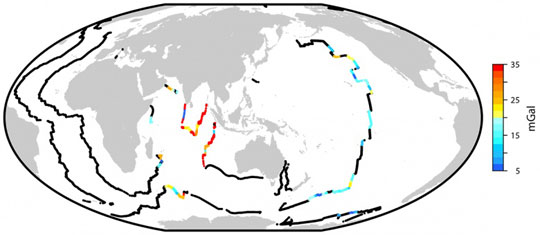Magma Outflow from Mid-Ocean Ridges Contributed to Dinosaur Demise
Magma Outpourings Along Oceanic Boundaries of Tectonic Plates
Scientists have concluded that magma outpourings along the edges of tectonic plates in the deep ocean may have contributed to the mass extinction event that marked the end of the Mesozoic. The increased volcanic activity could have contributed to the non-avian dinosaur extinction.
Researchers from the University of Oregon, in collaboration with colleagues from the University of Minnesota, identified gravity-related fluctuations dating to around the time of the end Cretaceous along ocean ridges that point to the worldwide release of volcanic magma. The outpouring of molten rock could have contributed to the global climatic catastrophe that marked the extinction of about 70% of all terrestrial lifeforms including the dinosaurs and their flying reptile cousins (Pterosauria).
The Extra-terrestrial Impact Event Could Have Exacerbated Volcanism Including Along Oceanic Ridges

Picture credit: University of Oregon/E. Paul Oberlander, Woods Hole Oceanographic Institution, Graphic Services
Lead author of the scientific paper, published in the academic journal “Science Advances” Joseph Byrnes, (Department of Earth Sciences, University of Minnesota), stated:
“We found evidence for a previously unknown period of globally heighted volcanic activity during the mass-extinction event.”
A “One-two” Knockout Blow
The team’s analysis of the strength of gravity along these ancient ocean ridges, points to a pulse of accelerated global volcanism that along with the massive outpourings known as the Deccan Traps of India would have significantly impacted upon the planet’s climate.
How much the enormous Deccan Traps contributed to the demise of the Dinosauria has been debated for decades. Huge volcanic events, fortunately quite rare, such as the outpourings of molten rock that at some places in India, are more than two kilometres thick and cover much of the western portion of the sub-continent, can have a colossal effect on the Earth’s climate. When these events do occur, they are very often linked to global mass extinctions. The expulsion of gas and ash into the air can block out the sun causing plants to die and ecosystems to collapse. Acid rain is also associated with the release of sulphur dioxide into the atmosphere from volcanoes.
With the discovery of the Chicxulub impact crater on the Yucatan Peninsula (Mexico), scientists have debated how much of an effect the Deccan Traps eruptions did have. Seismic data suggests that part of India was already active when the extra-terrestrial body hit the Earth around 66 million years ago, however, the impact was so massive, the resulting seismic shock waves moved through the Earth’s crust and probably led to an acceleration of those eruptions.
Co-author, Leif Karlstrom added:
“Our work suggests a connection between these exceedingly rare and catastrophic events, distributed over the entire planet. The meteorite’s impact may have influenced volcanic eruptions that were already going on, making for a one-two punch.”
The idea that the impact event increased volcanism gained credence in 2015 following research from scientists based that the University of California, Berkeley. They proposed that powerful seismic waves could have exacerbated distant volcanic eruptions, making the Deccan Traps even more active.
Mapping Gravity Anomalies in Mid-Ocean Late Cretaceous Environments

Picture credit: Joseph Byrnes
The Chicxulub Impact Event
This new research extends this exacerbated eruption idea to oceanic basins worldwide. To conduct the research, a geological map of the seafloor was divided into equally sized sections and the history of the ocean basins plotted back in time for more than 100 million years. At around 66 million years ago, the approximate time of the Chicxulub impact event, evidence for a “short-lived pulse of marine magmatism”, along the ancient ocean ridges where tectonic plates meet was found. This pulse is indicated by a spike in the rate of the occurrence of free-air gravity anomalies found in the data.
Free-air gravity anomalies, measured in tiny increments (milligals), account for variations in gravitational acceleration, found from satellite measurements of additional seawater collecting where the Earth’s gravity is stronger. Byrnes found changes in free-air gravity anomalies of between five and twenty milligals associated with seafloor created in the first million years after the impact event.
The scientific paper: “Anomalous K-Pg–aged Seafloor Attributed to Impact-induced Mid-Ocean Ridge Magmatism” by Joseph S. Byrnes and Leif Karlstrom published in the journal “Science Advances”
The Everything Dinosaur website: Everything Dinosaur.

